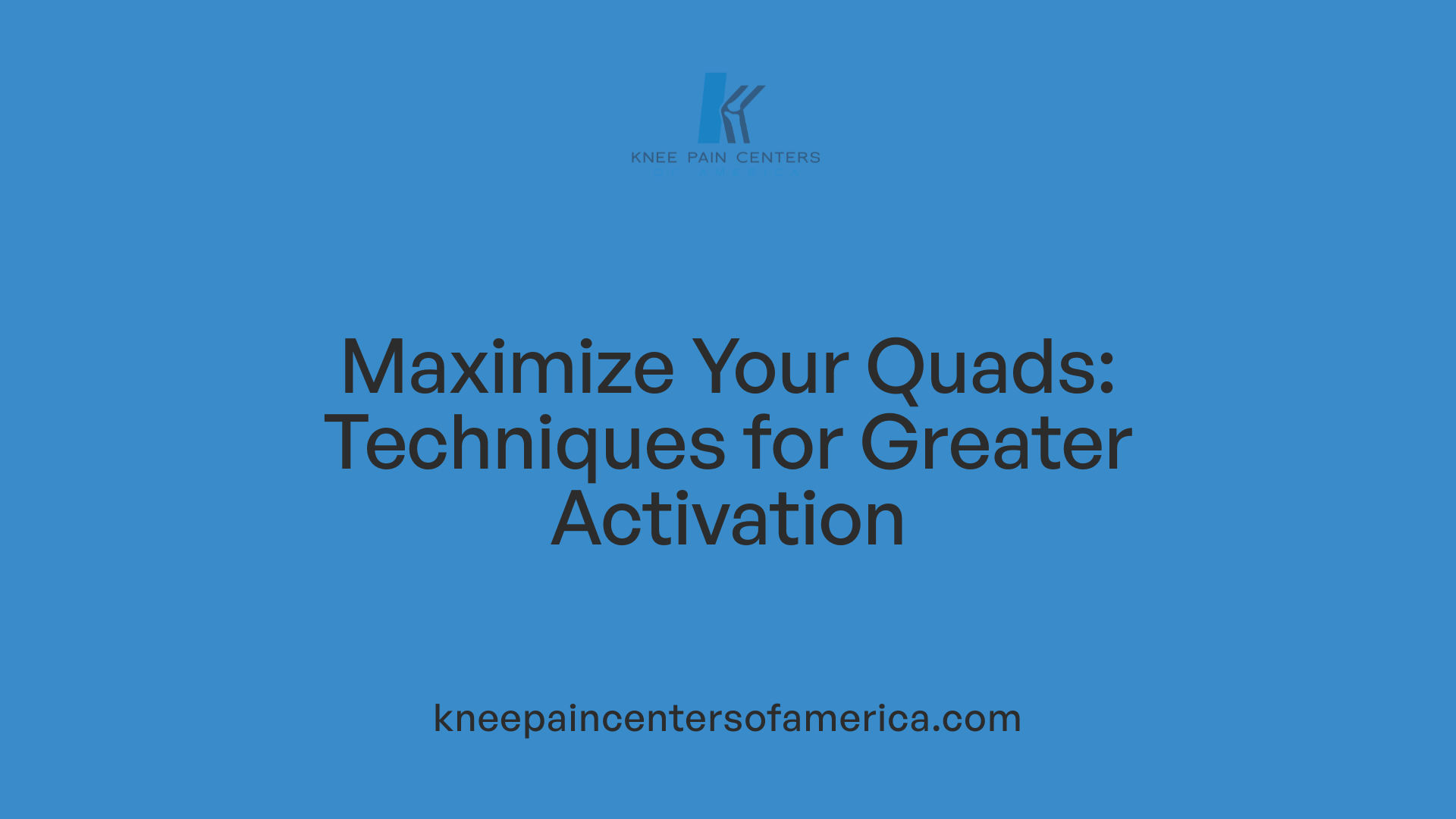Unlocking the Secrets to Powerful, Defined Quads
Developing strong, muscular quadriceps is fundamental for athletic performance, daily mobility, and a balanced physique. Whether you're a beginner, seasoned athlete, or rehabilitating from injury, understanding the most effective exercises and training strategies is vital. This comprehensive guide explores the anatomy of the quadriceps, the best exercises to target all four muscle heads, and practical routines to optimize growth, strength, and injury prevention.
Understanding Quadriceps Anatomy and Its Role in Movement

What are the quadriceps muscles?
The quadriceps are a group of four muscles located at the front of the thighs. These muscles include the rectus femoris, vastus lateralis, vastus medialis, and vastus intermedius. Each plays a vital role in extending the knee and flexing the hip, essential movements for daily activities and athletic performance.
The four muscles include:
- Rectus Femoris: Crosses both the hip and knee joints, aiding in hip flexion and knee extension.
- Vastus Lateralis: Located on the outer thigh, contributing mainly to knee extension.
- Vastus Medialis: Found on the inner part of the thigh, important for stabilizing the patella.
- Vastus Intermedius: Situated between vastus lateralis and medialis, deep in the thigh, assisting in knee extension.
Function and importance in daily activities and athletic performance
Strong quadriceps are crucial for efficient movement. They facilitate actions like walking, running, jumping, squatting, and stair climbing. In sports, powerful quads enhance speed, agility, and jumping ability.
Additionally, quadriceps support hip flexion and stabilize the knee joint. This stability is essential for injury prevention, especially for common issues like ACL tears or meniscus injuries.
Strong quads also contribute to maintaining independence in older age. They help in everyday movements like standing up, walking, and climbing stairs, which are vital for quality of life.
Impact on knee stability and injury prevention
The quadriceps play a critical role in maintaining knee stability by controlling the movement and position of the kneecap (patella). Properly functioning quads reduce the risk of knee injuries, including tears in the meniscus or ACL.
Research shows that resistance training improves not only muscle size but also enhances joint stability and reduces injury risk. Well-developed quadriceps provide better shock absorption and support, helping to prevent overuse injuries and degenerative conditions. Overall, a balanced and strong quadriceps profile is fundamental for both athletic excellence and everyday function.
Top Exercises for Quadriceps Strength and Hypertrophy

What are the best quad exercises for building muscle and strength?
Building strong and muscular quadriceps requires a mix of compound and isolation exercises. Compound movements such as the back squat, front squat, hack squat, and leg press are highly effective because they engage multiple muscle groups and allow for the use of heavy weights, which promotes muscle growth. These exercises activate the entire quadriceps, along with supporting muscles, making them ideal for overall strength development.
Isolation movements focus specifically on the quadriceps, helping to target all four heads of the muscle: rectus femoris, vastus lateralis, vastus medialis, and vastus intermedius. Examples include seated and lying leg extensions, as well as sissy squats that emphasize quad activation with body weight.
In addition, variations like heel-elevated goblet squats and front foot elevated split squats can stress specific parts of the quadriceps, encouraging balanced development. Combining these exercises with progressive overload and maintaining proper form ensures maximum muscle gains.
What are some effective variations of quad exercises for advanced trainees?
For those with advanced training experience, incorporating exercise variations can provide new challenges and stimulate further growth. Heel-elevated goblet squats increase the range of motion and highly target the quadriceps.
Bulgarian split squats, performed with the back foot elevated on a bench, improve unilateral strength and stability, which benefits overall leg development.
Banded Spanish squats help stabilize the knees and put a stronger emphasis on the quads, especially for those with knee issues. Descending below parallel in pendulum squats or similar exercises can intensify quad engagement.
Additional advanced options include weighted step-ups and jump squats that boost explosive power.
Adjusting foot placement or adding pauses at the bottom of squats can aid in overcoming plateaus and deepen quad activation. Progressive mastery of these variations enhances both strength and muscular contour.
How do different equipment options influence quad development?
Selecting the appropriate equipment can elevate your quad training. Free weights like barbells and dumbbells facilitate natural movement patterns that also recruit stabilizer muscles, leading to comprehensive development.
Machines such as the leg press, hack squat, and seated leg extension allow for controlled, targeted loading of the quadriceps. These are especially useful for isolating the muscles and reducing injury risk.
Resistance bands and TRX systems enable low-impact, functional exercises that improve stability, endurance, and muscular control.
Bodyweight movements like sissy squats and step-ups are versatile options that require minimal equipment and are effective for beginners or at-home workouts.
Using a mix of these equipment options introduces variability to your training, helping to prevent plateaus, address individual needs, and optimize muscle growth.
What are the most effective ways to incorporate quad exercises into a training cycle?
Embedding quadriceps exercises into your training routine involves strategic planning. Start by alternating between compound movements such as squats, lunges, and leg presses, and isolation exercises like leg extensions and sissy squats across your training sessions.
Aim for 3-4 exercises per workout, performing 3-4 sets of each, with a focus on moderate to high repetitions (12-20 reps). This rep range efficiently stimulates hypertrophy.
Schedule workouts twice weekly, ensuring sufficient rest and recovery days to promote muscle repair.
To maximize gains, progressively increase the resistance—adding weight, slowing the movement tempo, or increasing sets or reps—over time.
Incorporate variations like front squats, heel-elevated goblet squats, and unilateral moves such as lunges and step-ups. These target different parts of the quadriceps and improve functional strength.
Consistently evaluate progress and make routine modifications, whether by introducing new exercises, increasing resistance, or changing training volume, to continuously challenge the muscles and stimulate growth.
Specialized Exercise Techniques to Maximize Quadriceps Activation

What are some tips for optimizing quad training and preventing injuries?
To get the most benefits from quadriceps workouts and stay injury-free, proper form is essential. Exercises like squats, lunges, and leg presses should be performed with controlled, deliberate movements, paying attention to knee alignment and joint safety. Regular stretching and foam rolling of the quadriceps and surrounding muscles, such as the hip flexors, improve flexibility and reduce tightness that could cause strains.
Strengthening your quads through targeted exercises like split squats, step-ups, and resistance band routines helps build muscle stability. Gradually increasing the training intensity — called progressive overload — prevents overtraining and minimizes injury risks. Incorporate warm-up routines and rest days into your schedule.
If you feel any discomfort or pain, stop the exercise and seek guidance. Addressing issues early with the help of health or fitness professionals ensures your training remains safe and effective.
How can tempo and exercise variation improve quad activation?
Controlling the speed of movement, especially during eccentric (lowering) phases, increases the time your muscles spend under tension. For example, lowering into a squat slowly emphasizes muscle engagement in the quadriceps. Adding pause reps at the bottom of squats or partial ranges of motion can isolate specific parts of the muscle, making workouts more effective.
Varying your stance—such as wider or narrower foot placement—or switching between bilateral (both legs) and unilateral (one leg) exercises keeps training interesting and promotes balanced muscle development. These variations prevent plateaus and help achieve overall strength and size gains.
How do equipment modifications like heel elevation influence quad development?
Using equipment such as heel elevation inserts or wedge blocks during exercises like goblet squats or front squats enhances the tibia’s angle relative to the torso. This change shifts more load onto the quadriceps, especially the vastus medialis, promoting targeted growth.
Heel elevation allows for deeper range of motion while keeping knees tracking properly over the toes, which is safer and more effective. It also reduces strain on the lower back and knees, making exercises accessible for beginners or those with joint concerns. Additionally, adjusting foot position—such as a narrow stance or front foot elevation—can intensify quad activation further.
What is the role of unilateral exercises like lunges and step-ups in quad training?
Unilateral movements like lunges and step-ups are vital for addressing muscle balance and enhancing functional strength. They force each leg to work independently, recruiting stabilizer muscles for better balance and coordination.
Step-ups, especially when performed with added weight like dumbbells or barbells, strengthen the quads, glutes, and hamstrings in movements that mimic real-life actions. These exercises help correct asymmetries and improve symmetry across both legs.
Incorporating unilateral exercises not only boosts muscle development but also improves overall stability, making them perfect for athletes or anyone aiming for balanced leg strength.
How does progressive overload apply to quad training?
Progressive overload involves gradually increasing the challenge to your muscles so they continue to grow stronger and bigger. This can be achieved by adding weight, increasing the number of repetitions, or extending the range of motion in your exercises.
For example, you might start with bodyweight squats, then progress to weighted split squats, or increase resistance in leg extensions over time. Keeping track of your performance and pushing a little further each session ensures continuous muscle adaptation.
Applying this principle safely allows you to avoid plateaus, optimize growth, and prevent injury, especially when exercises are performed with proper form and control.
Putting It All Together for Quads That Perform and Impress
Developing optimal, well-rounded quadriceps requires strategic exercise selection, proper technique, and consistent effort. Incorporating a variety of compound and isolation movements—like squats, lunges, and leg extensions—targets all four heads and promotes balanced growth. Prioritize proper form, progressive overload, and recovery to prevent injuries and ensure continual improvement. Tailor your routines with variations like heel elevation, unilateral work, and tempo adjustments to maximize activation and muscle engagement. Remember, strong quads not only enhance athletic performance and daily function but also contribute to a balanced physique and injury resilience. Commit to consistent, informed training, and you'll unlock the full potential of your quadriceps, leading to bigger, stronger, and healthier legs.
References